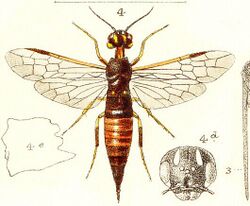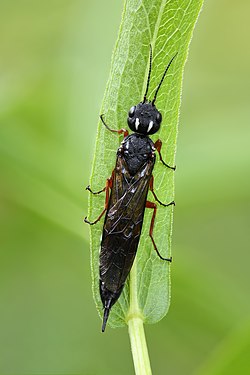Biology:Xiphydriidae
| Xiphydriidae | |
|---|---|

| |

| |
| Xiphydria type genus of the family Xiphydriidae | |
| Scientific classification | |
| Domain: | Eukaryota |
| Kingdom: | Animalia |
| Phylum: | Arthropoda |
| Class: | Insecta |
| Order: | Hymenoptera |
| Superfamily: | Xiphydrioidea |
| Family: | Xiphydriidae Leach, 1815 |
Xiphydriidae are a family of wood wasps that includes around 150 species. They are located all over the world including North and South America, Australia, Europe, and others.[1] Xiphydriidae larvae are wood borers in dead trees or branches of a range of trees.[2] They are characterized as having long and skinny necks with dome-shaped heads.[3] The oldest fossils of the group are from the mid Cretaceous.[4]
Genera
These 29 genera belong to the family Xiphydriidae:[5]
- Alloxiphia Wei, 2002
- Austrocyrta Riek, 1955
- Austroxiphyda Jennings, Macdonald, Schiff & Parslow, 2021
- Brachyxiphus Philippi, 1871
- Calexiphyda Smith, 2008
- Carinoxiphia Wei, 1999
- Derecyrta Smith, 1860
- Eoxiphia Maa, 1949
- Euxiphydria Semenov-Tian-Shanskii & Gussakovskii, 1935
- Genaxiphia Maa, 1949
- Gryponeura Benson, 1954
- Heteroxiphia Saini & Singh, 1987
- Hyperxiphia Maa, 1949
- Indoxiphia Maa, 1949
- Lataxiphyda Smith, 2008
- Lissoxiphyda Smith, 2008
- Megaxiphia Wei, 1999
- Moaxiphia Maa, 1949
- Obesaxiphyda Smith, 2008
- Platyxiphydria Takeuchi, 1938
- Rhysacephala Benson, 1954
- Steirocephala Benson, 1954
- Trixiphidia Wei, 1999
- Xiphidiaphora Benson, 1954
- Xiphydria Latreille, 1802
- Xiphydriola Semenov-Tian-Shanskii, 1921
- Yangixiphia Wei, 2002
- † Paraxiphydria Gao et al., 2022 Burmese amber, Myanmar Cretaceous Albian-Cenomanian
Anatomy and morphology
Head
Most of the species of Xiphydriidae have antennae that are filiform.[3] The antennal segments vary in number ranging from 14 to 22.[3] The maxillary and labial palpi shape and length varies by species. They have an occipital carina which is a ridge in the back of the head.[3] The head is somewhat spherical and is shiny.[6]
Thorax
The pronotum is medially constricted in Xiphydriidae.[6] The defined axillae completely separates the scutum laterally from the mesoscutellum.[7] Parts of the thorax for Xiphydriidae are generally smooth and shiny.[3]
Abdomen
The segment of the abdomen called the gaster can have an orange, red, or yellow coloring pattern.[7]
A study by David R. Smith broke the Xiphydriidae into different groups by their abdomen. The groups were as follows:
- Xiphydriidae that have a maxillary palpus segmented into 7.[3]
- Xiphydriidae that have short maxillary palpi and contain female fore claws with inner tooth.[3]
- Xiphydriidae that have short maxillary palpi and also contain claws of both sexes with inner tooth.[3]
Life cycle and development
Larva
The Xiphydriidae larvae phytophagous, meaning bore into dead or weak trees and plants.[7] When they are buried in these trees, they rely on symbiotic fungi for food in the tunnels that they made.[1] The larva either do not have legs or they have vestigial legs. During the larval stage, the head of Xiphydriidae is as long as broad.[8] As a larva, the antenna contains either three or four segments. The first segment of the antenna does not have setae and is not enlarged.[8]
Adult
Adults are 6-21mm long. Adult Xiphydriidae are most commonly found in shadowy places and run on the surface of leaves.[9] The adults have heads that are spherical which are attached to long and skinny necks.[3]
Ecology
Xiphydriidae bore and feed into dying or weakened trees so they do not have a negative effect to the environment.[10] They can be a secondary pest to humans because of the dead wood people may bring into their homes.[8] Xiphydriidae can be a host for parasitoid Aulacidae and they emerge from larvae that are fully grown.[11]
In Japan, female Xiphydriidae were dissected and fungal spores were found.[12] The spores were 5 to 30 micrometers in diameter and had a globular shape. Mucus was also in the glandular organs of some of the wood wasps.[12]
References
- ↑ 1.0 1.1 JENNINGS, JOHN T.; AUSTIN, ANDREW D.; SCHIFF, NATHAN M. (2007-06-28). "Rhysacephala novacaledonica sp. nov. (Hymenoptera: Xiphydriidae), the first xiphydriid woodwasp from New Caledonia". Zootaxa 1516 (1): 23–30. doi:10.11646/zootaxa.1516.1.2. ISSN 1175-5334. http://dx.doi.org/10.11646/zootaxa.1516.1.2.
- ↑ Smith, David (January 2014). "NOTES ON TWO UNUSUAL SPECIES OF SYMPHYTA (HYMENOPTERA: PERGIDAE, XIPHYDRIIDAE) FROM CHILE, WITH THE FIRST REPORT OF A GALL-INDUCING SAWFLY FROM THE NEOTROPICAL REGION". Boletín de la Sociedad Entomológica Aragonesa 54: 171–174. http://sea-entomologia.org/PDF/Boletin54/171174BSEA54PhiloperraChile.pdf.
- ↑ 3.0 3.1 3.2 3.3 3.4 3.5 3.6 3.7 3.8 Smith, David R. (2008-07-15). "Xiphydriidae of the Philippines, Insular Malaysia, Indonesia, Papua New Guinea, New Caledonia, and Fiji (Hymenoptera)." (in en). Beiträge zur Entomologie = Contributions to Entomology 58 (1): 15–95. doi:10.21248/contrib.entomol.58.1.15-95. ISSN 2511-6428. https://www.contributions-to-entomology.org/article/view/1717.
- ↑ Gao, Jia; Engel, Michael S.; Grímsson, Friðgeir; Gu, Lei; Ren, Dong; Gao, Tai-Ping (2022-01-04). "The first xiphydriid wood wasp in Cretaceous amber (Hymenoptera: Xiphydriidae) and a potential association with Cycadales" (in English). Fossil Record 24 (2): 445–453. doi:10.5194/fr-24-445-2022. ISSN 2193-0066. https://fr.copernicus.org/articles/24/445/2022/.
- ↑ Taeger, A.; Liston, A.D.; Prous, M.; Groll, E.K.; Gehroldt, T.; Blank, S.M. (2018). "ECatSym – Electronic World Catalog of Symphyta (Insecta, Hymenoptera)". Senckenberg Deutsches Entomologisches Institut (SDEI), Müncheberg. https://sdei.de/ecatsym/.
- ↑ 6.0 6.1 "Xiphydriidae | Sawfly GenUS". http://idtools.org/id/sawfly/factsheet.php?name=17601.
- ↑ 7.0 7.1 7.2 "Insects of Britain and Ireland: Hymenoptera families - Xiphydriidae". https://www.delta-intkey.com/britin/hym/www/xiphydri.htm.
- ↑ 8.0 8.1 8.2 Smith, David (July 1, 1976). "The xiphydriid woodwasps of North America (Hymenoptera: Xiphydriidae)". Transactions of the American Entomological Society 102 (2): 101–131. https://www.jstor.org/stable/pdf/25078190.pdf.
- ↑ Boevé, Jean-Luc; Domínguez, Diego F.; Smith, David R. (2018-06-25). "Sawflies from northern Ecuador and a checklist for the country (Hymenoptera: Argidae, Orussidae, Pergidae, Tenthredinidae, Xiphydriidae)". Journal of Hymenoptera Research 64: 1–24. doi:10.3897/jhr.64.24408. ISSN 1314-2607.
- ↑ Smith, David R. (2 October 2001). "A NEW SPECIES OF XIPHYDRIA LATREILLE (HYMENOPTERA: XIPHYDRIIDAE) REARED FROM RIVER BIRCH, BETULA NIGRA L., IN NORTH AMERICA". Transactions of the American Entomological Society 103: 962–967. https://www.srs.fs.usda.gov/pubs/ja/ja_smith009.pdf.
- ↑ "Aulacidae". http://tolweb.org/Aulacidae.
- ↑ 12.0 12.1 Kajimura, Hisashi (2000-03-01). "Discovery of Mycangia and Mucus in Adult Female Xiphydriid Woodwasps (Hymenoptera: Xiphydriidae) in Japan". Annals of the Entomological Society of America 93 (2): 312–317. doi:10.1603/0013-8746(2000)093[0312:domami2.0.co;2]. ISSN 0013-8746.
- Jennings, J. T.; Austin, A. D. & Bashford, R. (2009). "First record of the woodwasp family Xiphydriidae from Tasmania with a description of a new species and host record". Australian Journal of Entomology. 48: 25–28.
Wikidata ☰ Q604808 entry
 |


